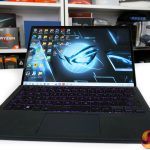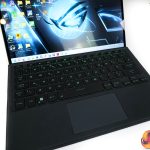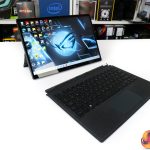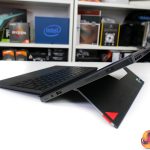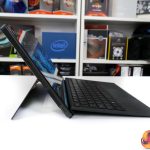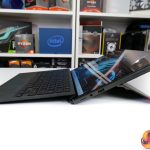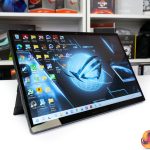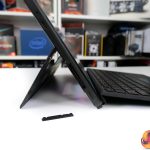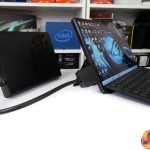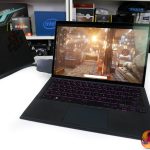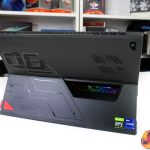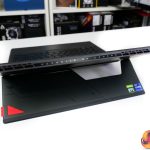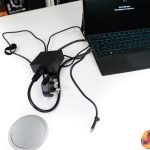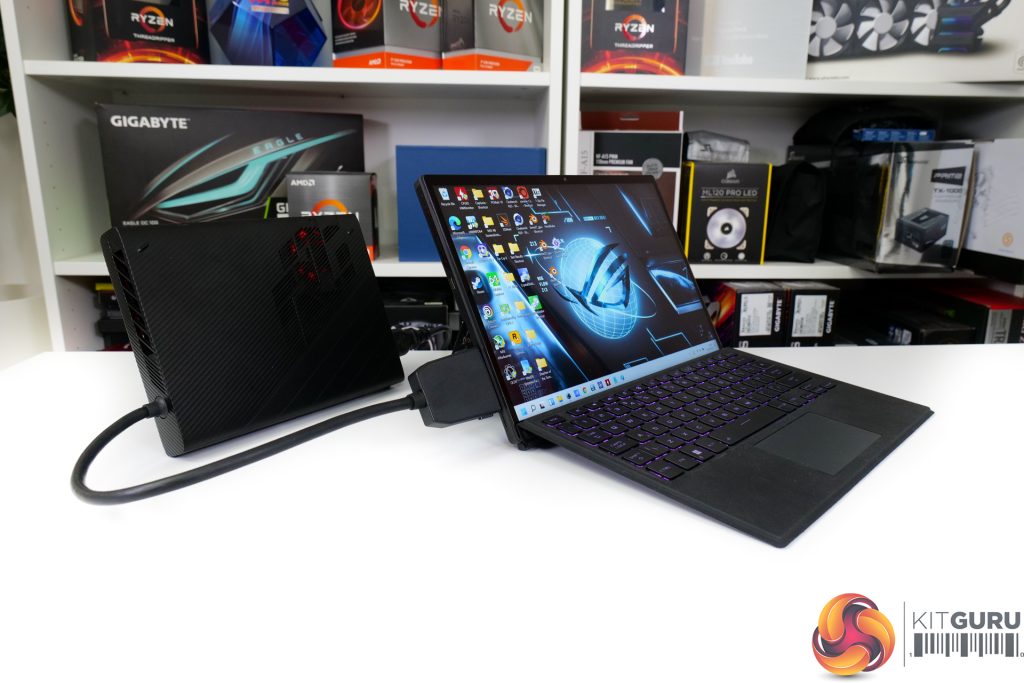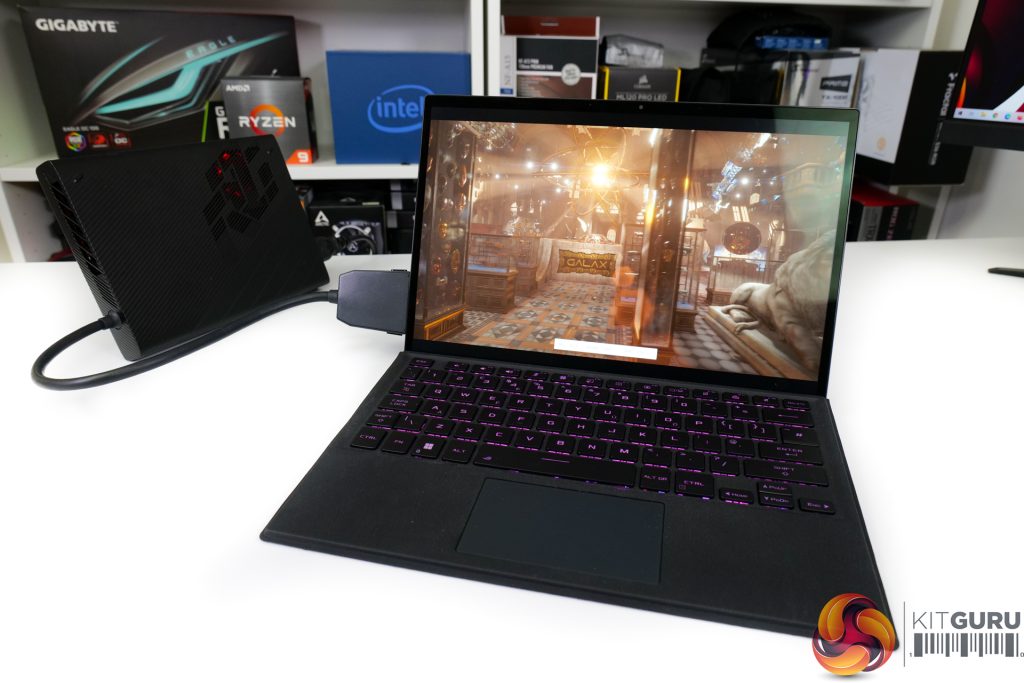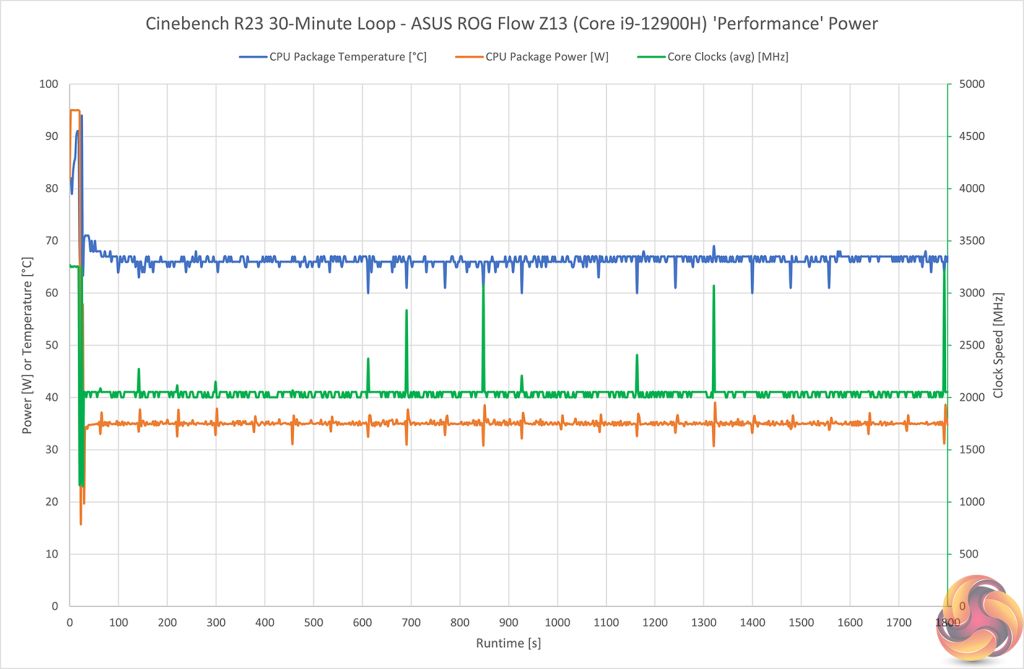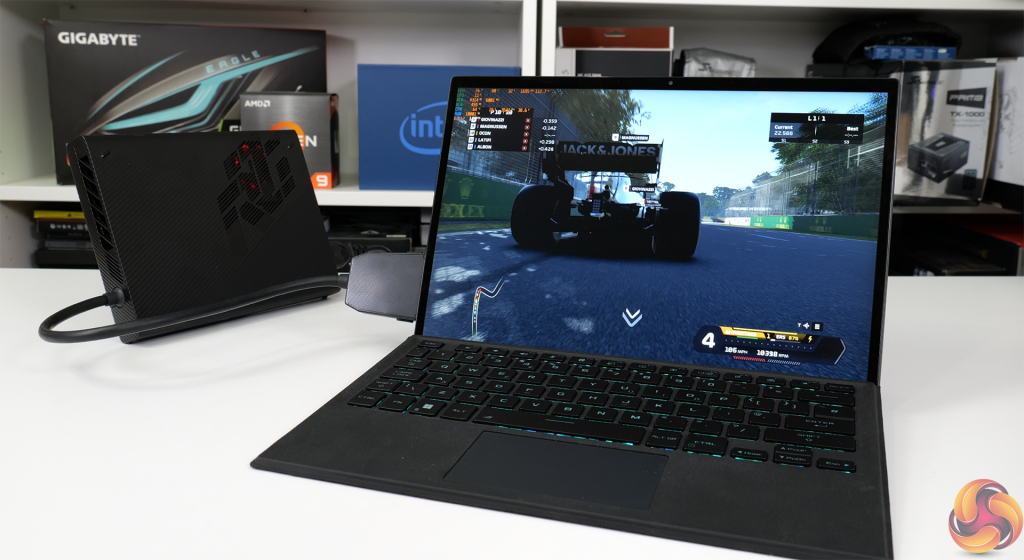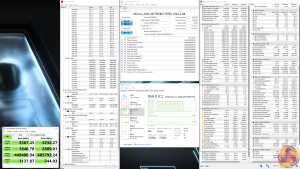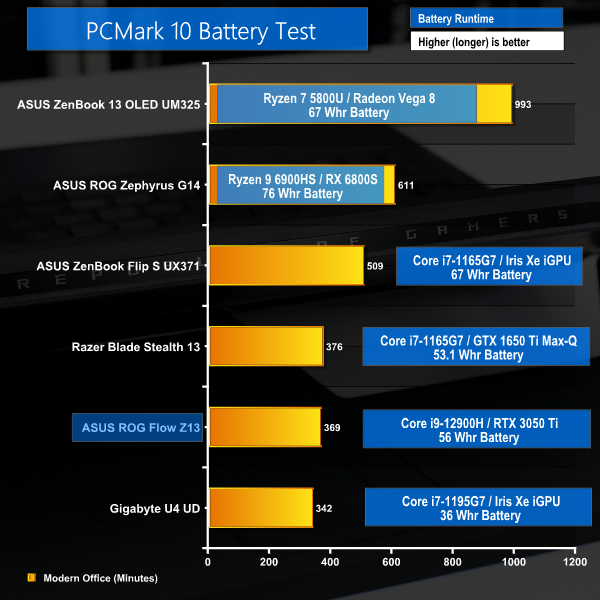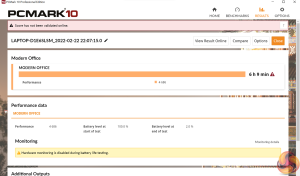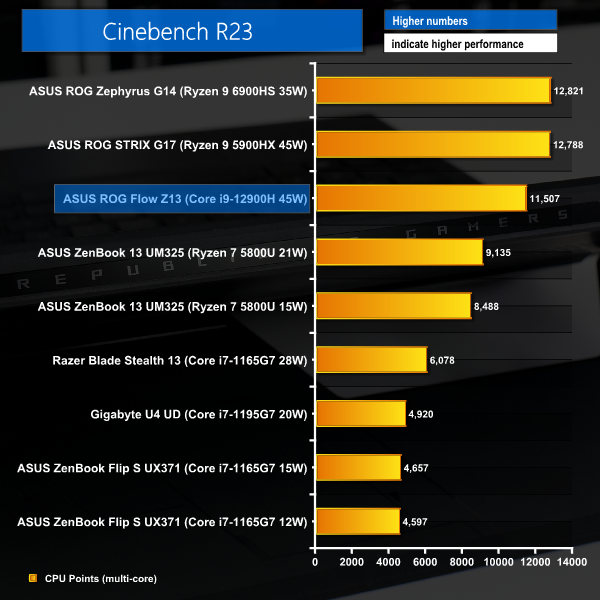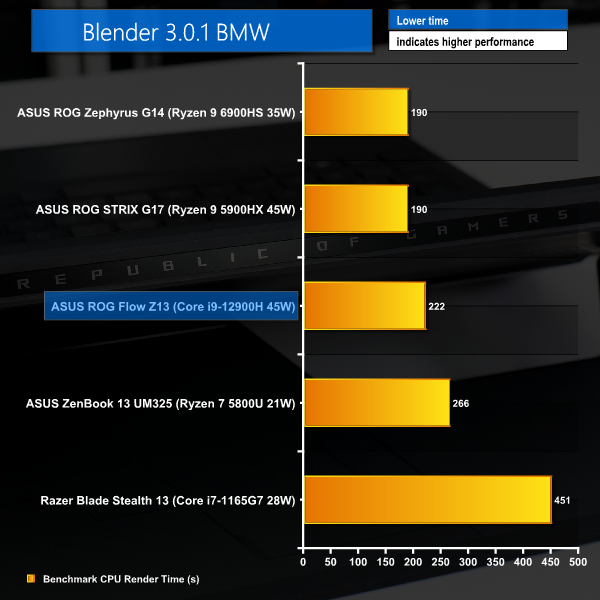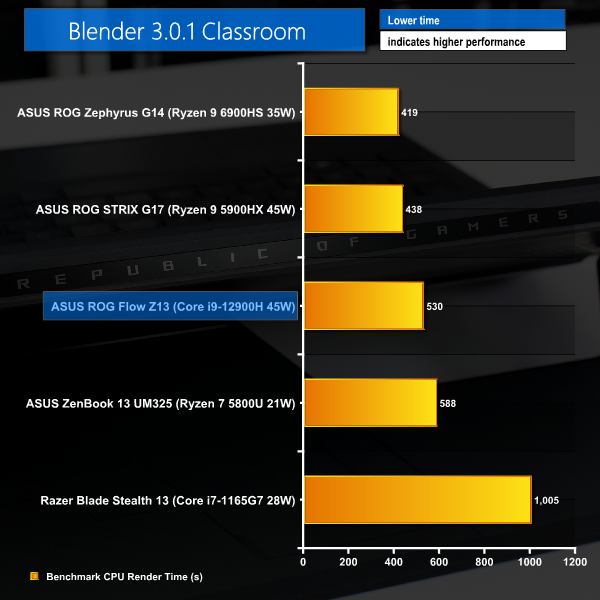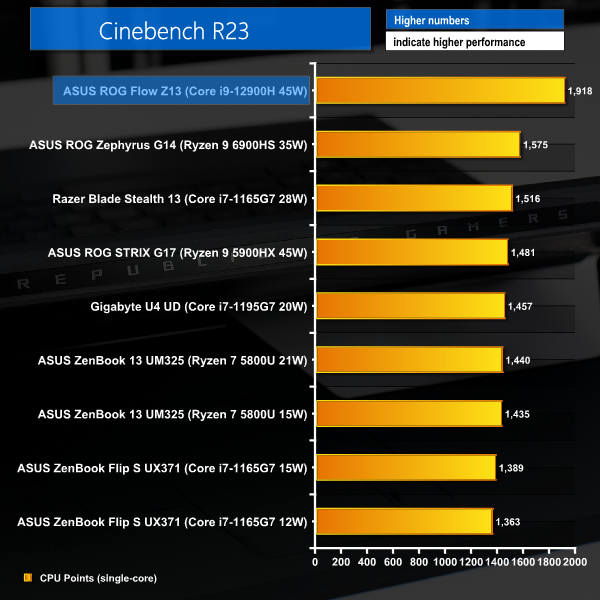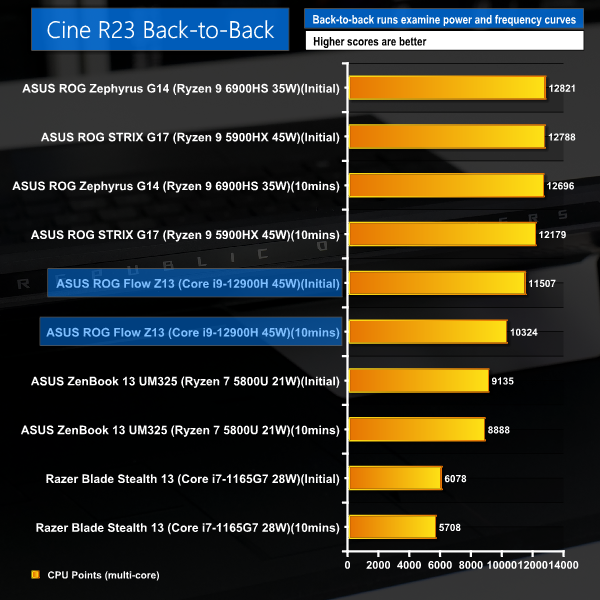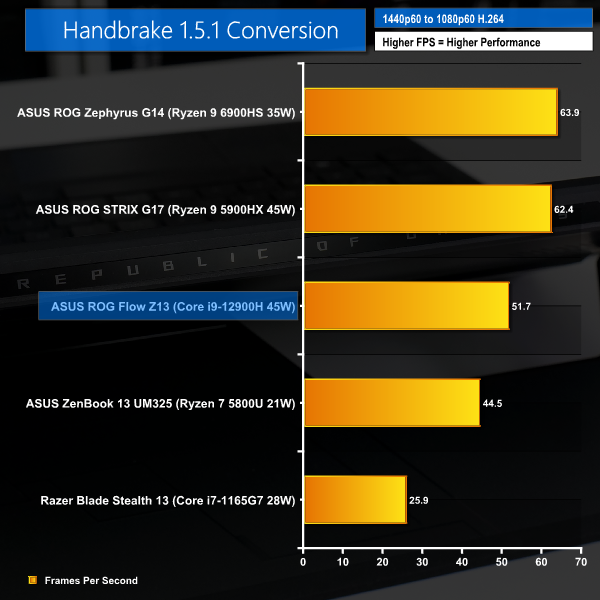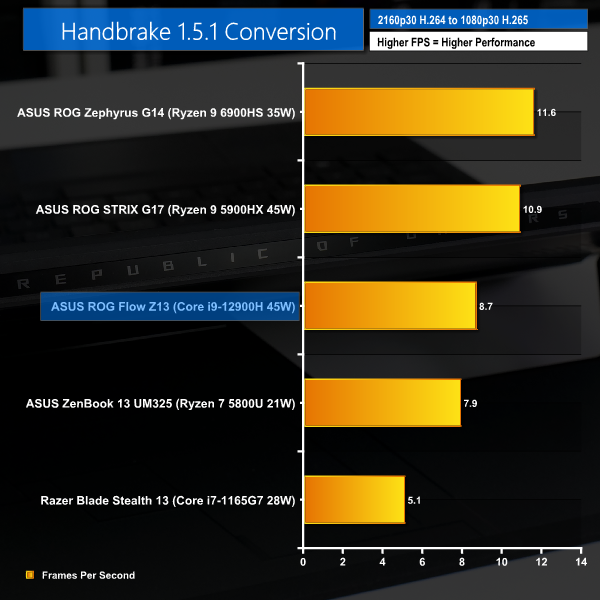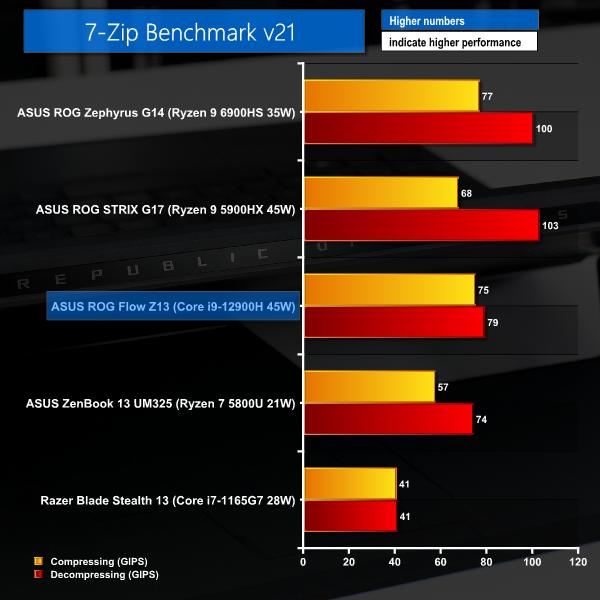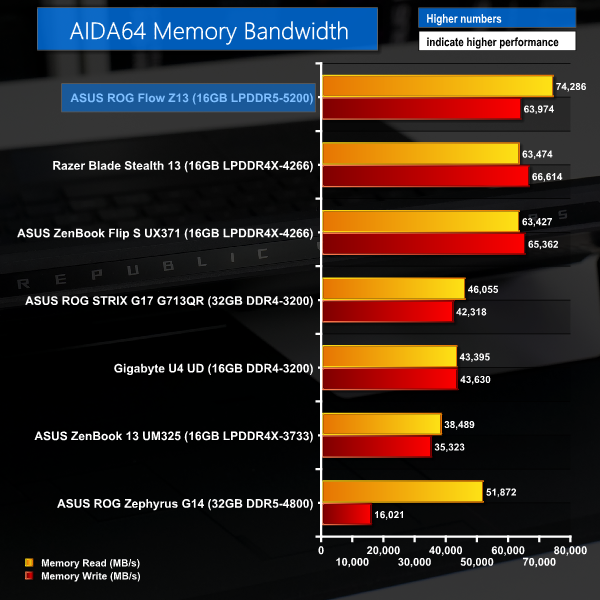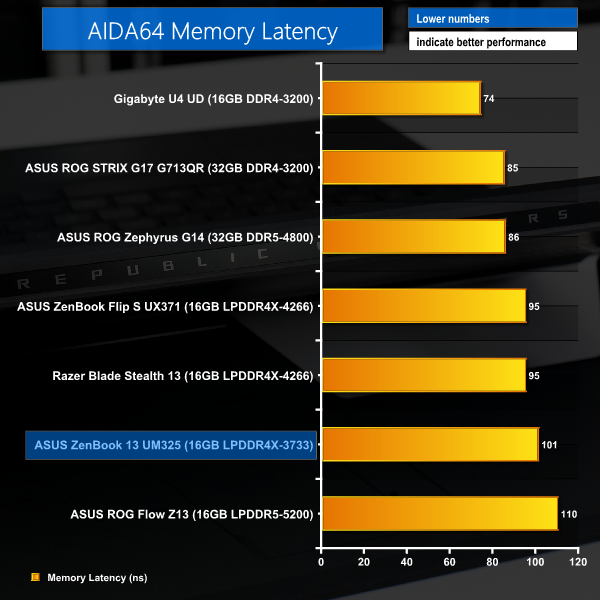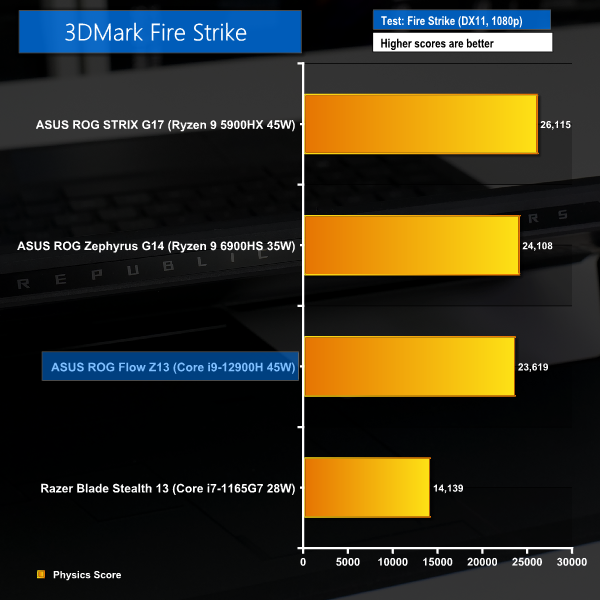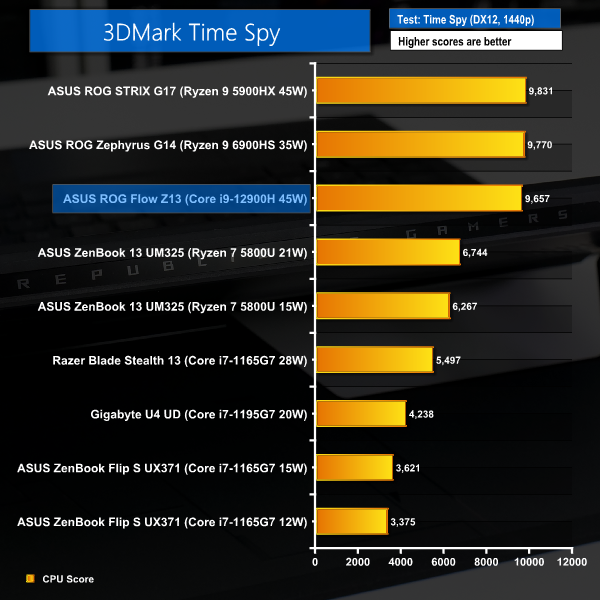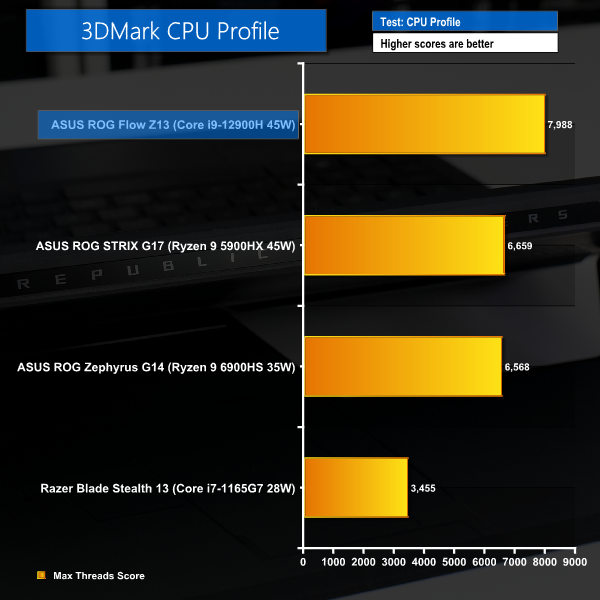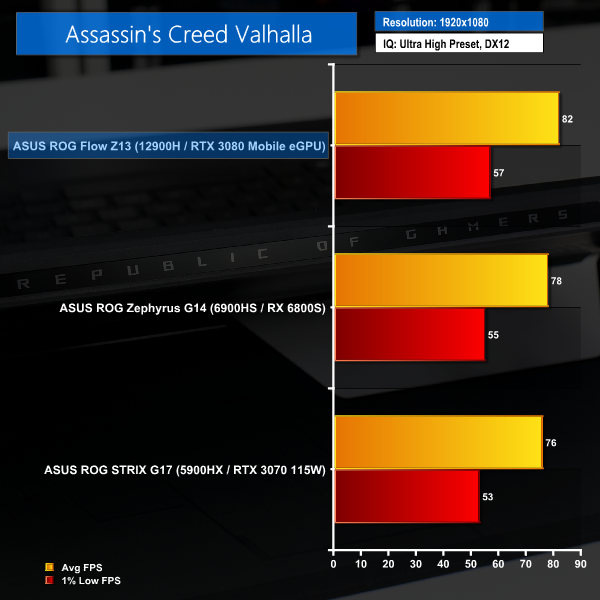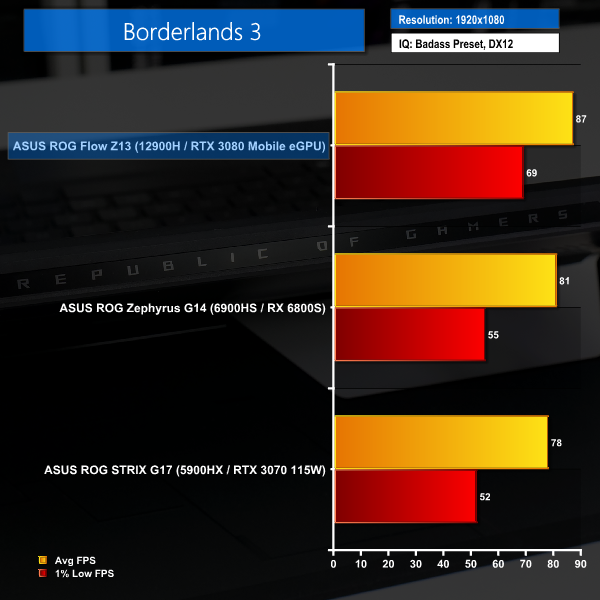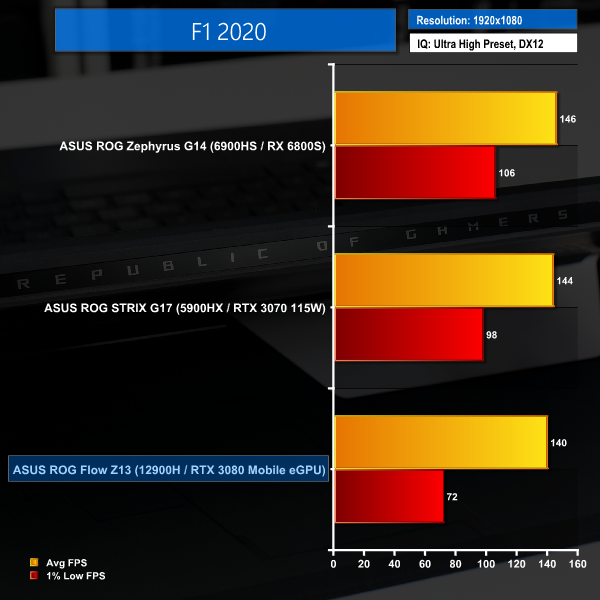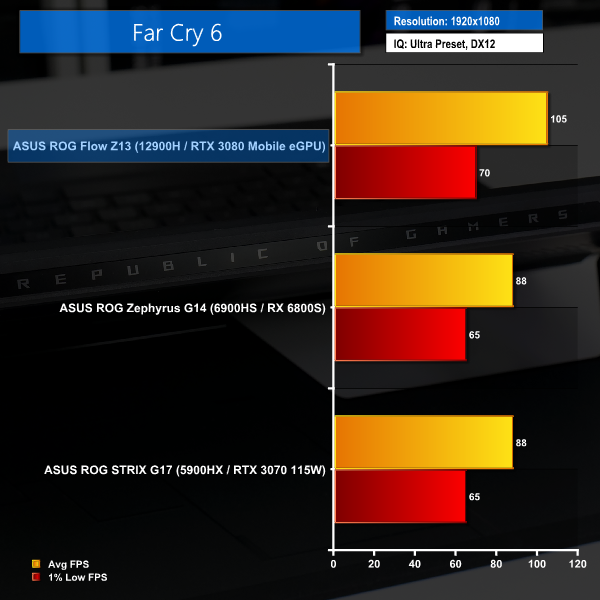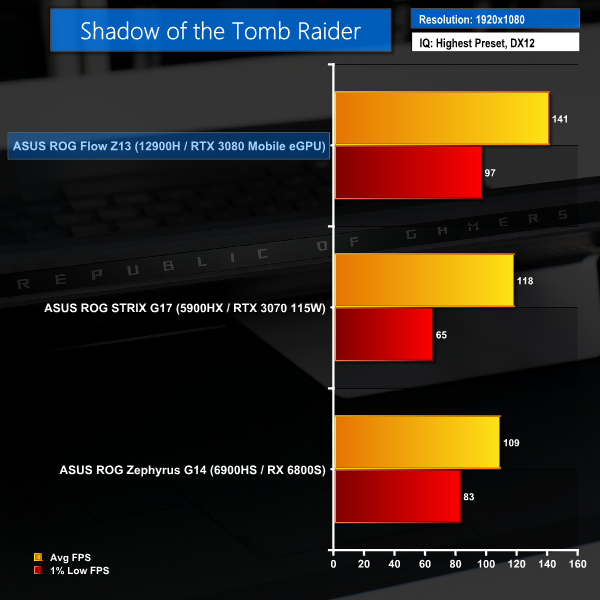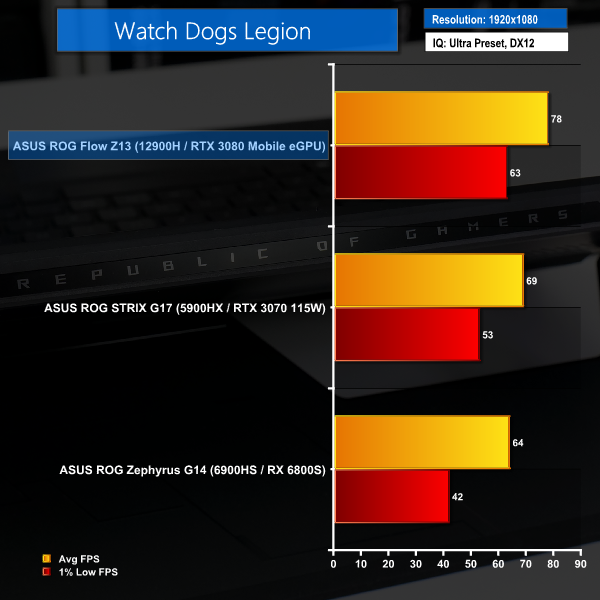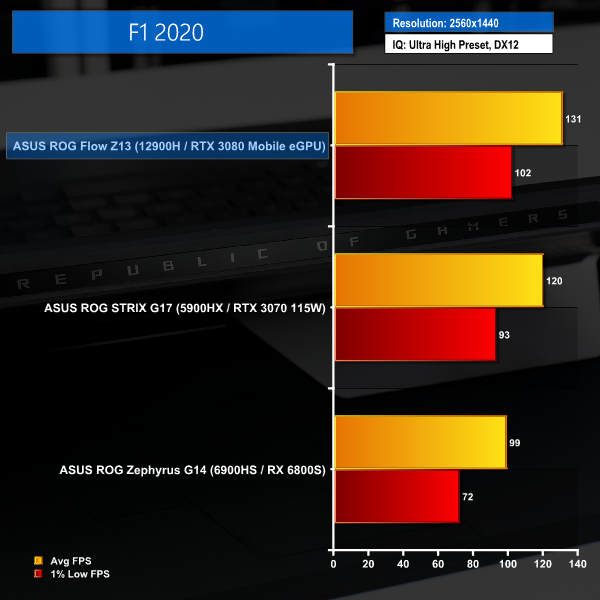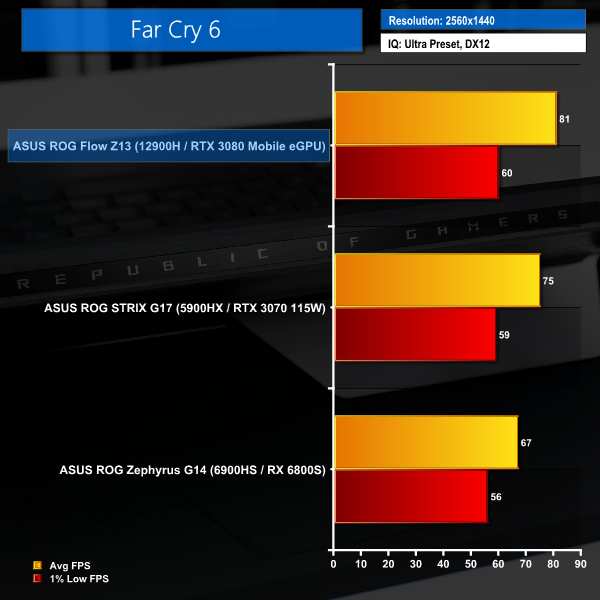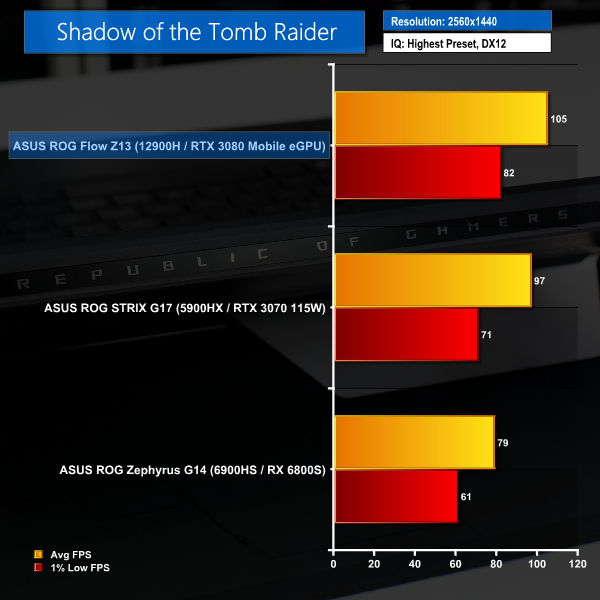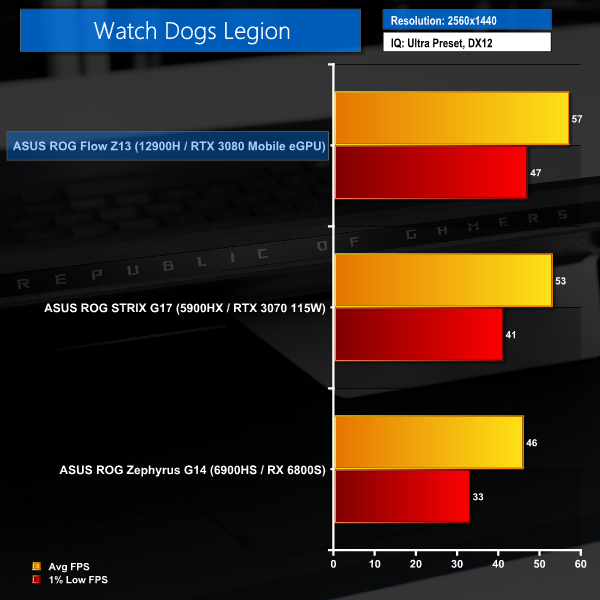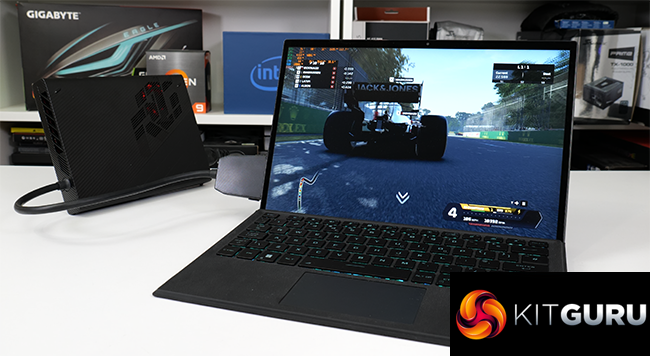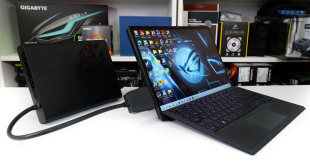
ASUS’ ROG Flow Z13 is a unique form factor that blurs the lines between an ultraportable laptop and a gaming-capable tablet. But don’t let that ‘tablet’ nametag put you off as this device sports some serious horsepower. With a 14-core Intel Core i9-12900H processor under the hood, alongside 16GB of high-speed LPDDR5 memory, and a RTX 3050 Ti Laptop GPU, horsepower is clearly evident.
Oh, and if you want some proper gaming muscle, connector capability for the ASUS ROG XG Mobile RTX 3080 Laptop eGPU solution is present. There are some pretty cool design features and performance options on show in this £1900 device.
Timestamps
If we start off with the design of ASUS' ROG Flow Z13, the overall form factor is more resemblant of a high-end tablet than a gaming laptop – it certainly blurs the lines between the two. You get a roughly 1.1kg, 12mm-thin chassis that houses the hardware and features a 170-degree integrated kickstand. Cooling holes on the top and back allow for venting of the Vapor Chamber cooling system that is deployed alongside Liquid Metal TIM.
The tablet feels good in one’s hand, but can function as a competent laptop-type device with that kickstand and the magnetic detachable backlit keyboard and trackpad solution. That detachable peripheral device also doubles up as a useful screen cover. Plus, it features the actually good keys alongside a reasonable-but-small trackpad.
The overall construction is high-quality, the unit feels solid, and it didn’t suffer attack by grubby fingerprints either. Though the soft textured keyboard does pick up dust very easily.
Primary to the under-the-hood hardware is the new Intel Core i9-12900H Alder Lake processor. This chip features 6 performance cores and 8 efficient cores for 20 threads total. It can Turbo as high as 5.0GHz with the 35-115W rated power range.
Memory comes in the form of 16GB of LPDDR5 clocked at 5200MHz. That’s good speed, but I would rather see 32GB for this calibre of device. Our unit ships with a 1TB PCIe Gen 4×4 NVMe SSD.
And for graphics we get an Nvidia GeForce RTX 3050 Ti Laptop with the Mux switch alongside the Alder Lake iGPU. That Nvidia dGPU runs somewhere in the 35-40W range under normal performance modes.
If an RTX 3050 Ti dGPU is a bit modest for some of your use cases, ASUS has you covered. Like we saw from the ROG Flow X13 that we reviewed back in early 2021, ASUS deploys its proprietary ROG XG Mobile connector interface. This is essentially a PCIe x8 link alongside a USB-C connector. ASUS uses this as an alternative to Thunderbolt and its sometimes-limiting x4 lane bandwidth.
We have the 16GB RTX 3080 Laptop version of the ROG XG Mobile GC31 eGPU for testing. This unit sports a 280W power supply that also feeds power to the laptop when connected.
Another benefit is the addition of connection ports such as Gigabit Ethernet, 5Gbps USB Type-A, HDMI 2.0b, DP 1.4, and an SD card reader.
If we go back to focussing on the ROG Flow Z13 itself, the 13.4-inch IPS-level display is a 16:10 form factor with touch capability and Adaptive Sync supported. We got the 1920×1200, 120Hz, 100% sRGB option which I think is a smart solution for this type of device.
You get a rear 8MP camera that is good for tablet duties and a 720p webcam that does not support Windows Hello. But the power button doubles up as a fingerprint reader.
Connectivity is a single Thunderbolt 4 port that can do 100W charging, a micro-SD card reader, a 3.5mm combo audio jack, a 10Gbps USB 3.2 Gen 2 Type-C port that supports power delivery and DisplayPort and doubles up for the ROG XG Mobile Interface.
Oh, and the single Type-A port is ancient USB 2.0 spec which is an absolutely ridiculous decision by ASUS that I am genuinely furious about! You also get WiFi 6E 2×2 and Bluetooth 5.2 connectivity.
Charging of the 56Whr battery is done by an included 100W USB-C adapter. This is excellent to see the USB-C charging ecosystem being used well.
Pricing for the ASUS ROG Flow Z13 in its Core i9-12900H and RTX 3050 Ti form is around £1900 from OverclockersUK. With the RTX 3080 eGPU, that bumps up to £3K.
This is around £700 more expensive that the ROG Flow X13 AMD version that is perhaps the most logical competitor (as the Surface Pro uses significantly lesser hardware). That’s a hefty price difference!
We test in the out-of-the-box state with minimal adjustments made to the laptop, other than installing our test software and Windows updates in addition to removing McAfee which is simply infuriating (ASUS, please stop including this!).
That means that each laptop is tested using its ‘Performance’ fan and power profile. We do not use the ‘Turbo' power profile which, in some respects, pushes the hardware (particularly the CPU) beyond the intended power limits from a design perspective. We will examine the behaviour of the ‘Performance' power profile in this review.
It is tricky to pit the ROG Flow Z13 against direct competitors because it is such a unique solution. As such, we include some comparison data from relevant laptops that we have tested recently.
Notably, we have the new AMD Ryzen 9 6900HS and RX 6800S – powered ROG Zephyrus G14. Price wise, these laptops are not too dissimilar, excluding the Flow’s eGPU dock. Make sure to check out our recent review for that impressive laptop.
We also deploy the ASUS ROG STRIX G17 that we reviewed on the main KitGuru website. This uses a 45W-calibre Ryzen 9 5900HX and a 115W RTX 3070 Laptop GPU. Despite being a much larger 17-inch unit, it will be interesting to see the CPU and GPU performance comparison.
And for some additional test data, we include a 21W-running Ryzen 7 5800U-based ASUS ZenBook 13 and a 28W-rated Core i7-1165G7 Tiger Lake-based Razer Blade Stealth 13.
ASUS ROG Flow Z13 Laptop Test Configuration:
- Processor: Intel Core i9-12900H (6 P-cores, 8 E-cores, up to 5.0GHz Turbo, 35-115W Rated TDP)
- Memory: 16GB LPDDR5 5200MHz
- Graphics Card: Nvidia GeForce RTX 3050 Ti 4GB GDDR6, Mux switch
- Display: 13.4” 16:10 WUXGA 1920×1200 120Hz IPS-level
- System Drive: 1TB Micron 2450 PCIe Gen4x4 NVMe SSD
- Battery: 56 Whr battery with 100W USB-C Power Adapter
- Design: Around 1.1-1.2kg weight with around 12mm chassis thickness
- Operating System: Windows 11
Comparison Systems:
- ASUS ROG Zephyrus G14 GA402RK (Ryzen 9 6900HS System):
- AMD Ryzen 9 6900HS (8C/16T, 3.3GHz Base, up to 4.9GHz Boost 35W Rated TDP Mode)
- 32GB DDR5 4800MHz
- AMD Radeon RX 6800S 8GB GDDR6
- 14” 16:10 QHD+ 2560×1600 120Hz IPS-level
- 1TB Micron 2450 PCIe Gen4x4 NVMe SSD
- 76 Whr battery with 240W barrel-style Power Adapter (100W USB-C support)
- 1.75kg weight with around 18.5mm chassis thickness
- ASUS ROG STRIX G17 G713QR (Ryzen 9 5900HX ‘Cezanne' System):
- AMD Ryzen 9 5900HX (8C/16T, up to 4.6GHz Boost, 45W Rated TDP)
- 32GB DDR4 3200MHz SODIMM
- RTX 3070 Laptop GPU 8GB GDDR6 115W
- 17.3-inch FHD (1920 x 1080) 16:9 300Hz IPS-level
- 1TB SK Hynix BC711 PCIe Gen 3×4 NVMe SSD
- 90 Whr battery with 240W barrel-style Power Adapter
- 2.70kg weight with 23.4-28.3mm chassis thickness
- Gigabyte U4 UD-70UK823SO (Core i7-1195G7 ‘Tiger Lake’ System)
- Intel Core i7-1195G7 (4C8T, 28W Rated TDP-up Mode)
- 16GB DDR4 3200MHz (8GB onboard, 8GB SODIMM)
- Integrated Intel Iris Xe iGPU (96 EUs)
- 14″ IPS Full HD 1920×1080 60Hz
- 512GB ESR512GTLG-E6GBTNB4 PCIe Gen4x4 NVMe SSD
- 36 Whr battery with 65W barrel-style Power Adapter
- Slightly below 990g weight with 16.5mm chassis thickness
- Razer Blade Stealth 13 OLED (Core i7-1165G7 ‘Tiger Lake’ System)
- Intel Core i7-1165G7 (4C8T, 28W Rated TDP)
- 16GB LPDDR4 4266MHz
- Nvidia GTX 1650 Ti Max-Q
- 13.3″ OLED Full HD Touch 60Hz
- 512GB Samsung NVMe SSD
- 53.1 Whr battery with 100W USB-C Power Adapter
- 1.41kg weight with 15.3mm thickness
- ASUS ZenBook Flip S OLED UX371 (Core i7-1165G7 ‘Tiger Lake-U’ System):
- Intel Core i7-1165G7 (4C/8T, 1.2GHz Base, 12W Rated TDP-down Mode)
- 16GB LPDDR4X 4266MHz
- Integrated Intel Iris Xe iGPU (96 EUs up to 1.3GHz)
- 13.3” 16:9 UHD 3840×2160 60Hz OLED Touch Display
- 1TB WD SN730 NVMe SSD
- 67 Whr battery with 65W USB-C Power Adapter
- 1.2kg weight with 11.9-13.9mm chassis thickness
- ASUS ZenBook 13 UM325S (Ryzen 7 5800U ‘Cezanne' System):
- AMD Ryzen 7 5800U (8C/16T, 1.9GHz Base, up to 4.4GHz Boost, 15W Rated TDP)
- 16GB LPDDR4X 3733MHz
- Integrated Radeon Vega 8 APU (up to 2GHz)
- 13.3” 16:9 FHD 1920×1080 60Hz OLED Display
- 1TB SK Hynix (HFM001TD3JX013N) NVMe SSD
- 67 Whr battery with 65W USB-C Power Adapter
- 1.12kg weight with 13.9mm chassis thickness
Tests
- Cinebench R23 – All-core & single-core CPU benchmark (CPU Compute), Stress test (Temperatures & Power Consumption)
- Blender 3.0.1 – All-core rendering of the Classroom and BMW scenes (CPU/GPU Compute), Stress test (Temperatures & Power Consumption)
- HandBrake 1.5.1 H264 – Convert 1440p60 H264 video to 1080p60 H264 using the YouTube HQ 1080p60 preset (CPU)
- HandBrake 1.5.1 H265 – Convert 4K30 100Mbps H264 video to 1080p30 40Mbps H265 using the H.265 MKV 1080p30 preset (CPU & Memory)
- 7-Zip 21.07 – Built-in 7-Zip benchmark test (CPU & Memory)
- SiSoft Sandra – Memory bandwidth and Cache & Memory Latency Test (Memory)
- AIDA64 – Memory bandwidth & memory latency (Memory)
- PCMark 10 – Modern Office & Battery Life Test (System Performance & Battery Life)
- 3DMark – Time Spy (1440p) test, Fire Strike (1080p) test, CPU Profile test (Gaming)
Temperatures, Clocks, and Power
Looking at the chart for temps, power, and clocks gives us a good overview of how the Core i9-12900H CPU operates in the ROG Flow Z13 under the default Performance power mode.
We see the processor quickly spike up in power and temperature and clocks, but it very soon settles down to its sensible long-term level. This looks to be around 35W package power draw which corresponds to a little over 2GHz average frequency for the 14 cores.
ASUS does well to squeeze 35W long duration CPU capability into this form factor. But 2.4GHz on the P-cores and 1.8GHz on the E-cores is a notable drop from their headline frequency.
So, we will have to see how the performance holds out.
Quickly noting the performance metrics when running the ROG XG Mobile RTX 3080 eGPU, this is a little less important than the laptop itself, as the external dock unit has its own power delivery and cooling to manage its performance.
Back-to-back runs of F1 2020 at 1080p had the RTX 3080 Laptop GPU liking a power draw of around 120W peak. This allowed the CPU to operate relatively freely at around 40W thanks to bouncing up and down as the gaming load changed. Wall power draw for the entire solution was around 190W total.
If you want more performance for 4K as an example, some of the other ASUS power modes with more aggressive voltage delivery and noise curves may be worth looking into.
Noise
You can see an example of our noise testing result in the video review.
The noise output seems perfectly reasonable in my opinion, especially for the horsepower squeezed into this compact form factor.
Though there’s definitely notable output from the XG Mobile eGPU when running a gaming load. I guess that’s a solution for gaming with headphones or a few feet away from a big TV.
SSD
I’ll use the exact same analysis as from the ASUS ROG Zephyrus G14 for this unit’s SSD.
As usual, ASUS seems to have a passion for cheaping out and providing entry-level SSDs even in its expensive, high-end systems, which is highly disappointing. There’s little to indicate that this Micron 2450 SSD actually benefits from its PCIe Gen 4×4 connection in terms of speed.
Battery
Battery life is very much mediocre at around 6 hours in PCMark 10. That’s down to the 56 Whr battery that appears relatively small when coupled with an Intel H-series CPU. Ample USB-C charging is great, but don’t expect all-day battery life from the ROG Flow Z13.
Intel’s new architectural and core count design for the Alder Lake laptop chips results in strong multi-threaded performance numbers.
While AMD’s new Ryzen 9 6900HS inside a physically larger laptop may be quicker in our testing – particularly in longer duration benchmarks. That’s due to the AMD chip running at 45W real-world versus the Core i9-12900H in the Flow being at 35W real-world.
Performance from Intel’s chip is good, particularly when factoring in the slim design of this gaming tablet/laptop.
With the ability to boost up to lofty frequencies on its new Alder Lake architecture, the Core i9-12900H-equipped Flow Z13 tops our Cinebench 1T chart by a very sizable margin! That speaks volumes about the lightly-threaded performance potential that is important for this tablet-style device.
With focus on multi-threaded operations, there is clear and measurable slowdown due to cooling and power limitations after extensive Cinebench runs.
Handbrake shows the similar picture; AMD’s new HS-series chip may be faster when inside a 14”-style laptop. But when viewed through the prism of this thin, sub-1.2kg device, ASUS and Intel deliver very solid performance indeed.
7-Zip is an area where Intel has clearly closed a lot of ground. AMD still wins handsomely in decompressing, but Intel does well in compressing. That’s aided by the high-speed LPDDR5 memory.
Running at 5200MHz, even a modest 16GB solution delivers some mega bandwidth numbers. And we don’t see any write-speed quirkiness from the Intel-based Flow Z13 like we see from ASUS’ AMD laptop.
Latency, though, that’s the clear downside of LPDDR5 memory.
3DMark Time Spy has the Z13 neck-and-neck with the G14 in its CPU score. Fire Strike also shows that the Core i9-12900H has strong gaming potential, despite its power-limited deployment. And the CPU-focussed test actually shows the ROG Flow Z13 flexing its muscle for processor capability.
Unsurprisingly, the acceleration abilities of the Intel/Nvidia combination do well for ASUS’ gaming tablet in PCMark 10.
A high-powered RTX 3080 Laptop GPU via the XG Mobile docking solution allows the ROG Flow Z13 to comfortably sit at the top of many 1080p gaming charts. This comes as no surprise versus the logical comparison points we have. But it is good to see that Intel’s Core i9-12900H is able to keep pace with the speedy Nvidia GPU that also has a healthy power budget.
We do see slight signs of weakness whereby the Ryzen 6000 competitor overtakes the Z13 in F1 2020 with its high frame rates. But realistically, the Core i9-12900H and RTX 3080 Laptop eGPU present as a strong combination for the ROG Flow Z13 at 1080p.
Looking at some 1440p gaming via an external monitor on each solution, the ROG Flow Z13 really cements its leadership position with the resolution cranked up, ASUS’ G17 with a 115W RTX 3070 Laptop GPU gets close. But the slightly higher power allocation and better underlying hardware of the RTX 3080 eGPU take the victory for ASUS’ ROG Flow Z13.
This is a good 1440p gaming laptop with the ROG XG Mobile.
We have to give ASUS credit for designing and deploying such a unique device to the market in the ROG Flow Z13. The most logical comparison is via the Microsoft Surface Pro line of devices. But realistically, ASUS has no real competitor with the amount of horsepower that is squeezed into this slim and light chassis. Plus, the external docking solution gives ample opportunity to extend graphics performance and connectivity.
The Core i9-12900H is a fast chip that does well even in the 35W power-restricted form. Yes, there is clearly more performance available that cannot really be accessed with this chassis and cooling setup. But, it is good to see Intel finally offering chips that can competently scale down their power whilst maintaining good performance.
The ROG XG Mobile eGPU solution works well and achieves its goal of expanding graphics performance. Our previous testing with the ROG Flow X13 has shown that ASUS’ 8-lane approach for external connectivity is good, particularly when looping back to the laptop display. And I guess the inclusion of TB4 port also provides users with options, so that’s good.
But I can’t help but feel that Thunderbolt is still a more all-encompassing solution for external devices. Particularly as Thunderbolt eGPU enclosures will take a proper, full-fat desktop GPU.
Thermals, noise, build quality – ASUS does well on all these fronts. And I have no complaints about the peripherals either, particularly the high-refresh rate, 16:10 touch display which is good.
There are clear downsides though. 16GB of RAM is hardly inspiring for a device of this calibre. That will actually be a deal-breaker to many potential customers. ASUS insists on using a mediocre SSD even for a high-end, pricey device like this. The battery life is not very good and realistically will struggle with a working day of general usage.
And, most annoyingly, the single USB Type-A port on the ROG Flow Z13 is USB 2.0 spec. That’s utterly ludicrous. I am actually struggling for the words to explain how ridiculous that is for a 2022 device.
We will give ASUS credit for innovating with the ROG Flow Z13. But that innovation comes at a serious cost and really does present pricing as an issue, because the ROG Flow X13 AMD with its Ryzen 9 5900HS is £700 cheaper for the eGPU or non-eGPU solution.
At £700 extra for the Intel-equipped ROG Flow Z13 edition, you have to put some serious weight on the truly tablet form factor here.
You can buy the ROG Flow Z13, as reviewed, for £2999.99 (including RTX 3080 dock) from OverclockersUK HERE. The same laptop without the RTX 3080 dock is £1899.95 HERE.
Discuss on our Facebook page HERE.
Pros:
- Superb, innovative design with excellent build quality
- Impressive CPU and GPU horsepower squeezed in
- Good cooling performance and power delivery
- ROG XG Mobile Connector is a benefit
- 1920×1200 120Hz touch display is good
Cons:
- No USB 3.0 Type-A (USB 2.0 is ridiculous)
- Mediocre battery life
- Only 16GB RAM
- Modest SSD Performance
- Very expensive even versus the ROG Flow X13
KitGuru says: ASUS deserves plenty of credit for an innovative, well-engineered solution. But the ROG Flow Z13 is an incredibly niche product with some notable downsides and limitations.
 KitGuru KitGuru.net – Tech News | Hardware News | Hardware Reviews | IOS | Mobile | Gaming | Graphics Cards
KitGuru KitGuru.net – Tech News | Hardware News | Hardware Reviews | IOS | Mobile | Gaming | Graphics Cards


